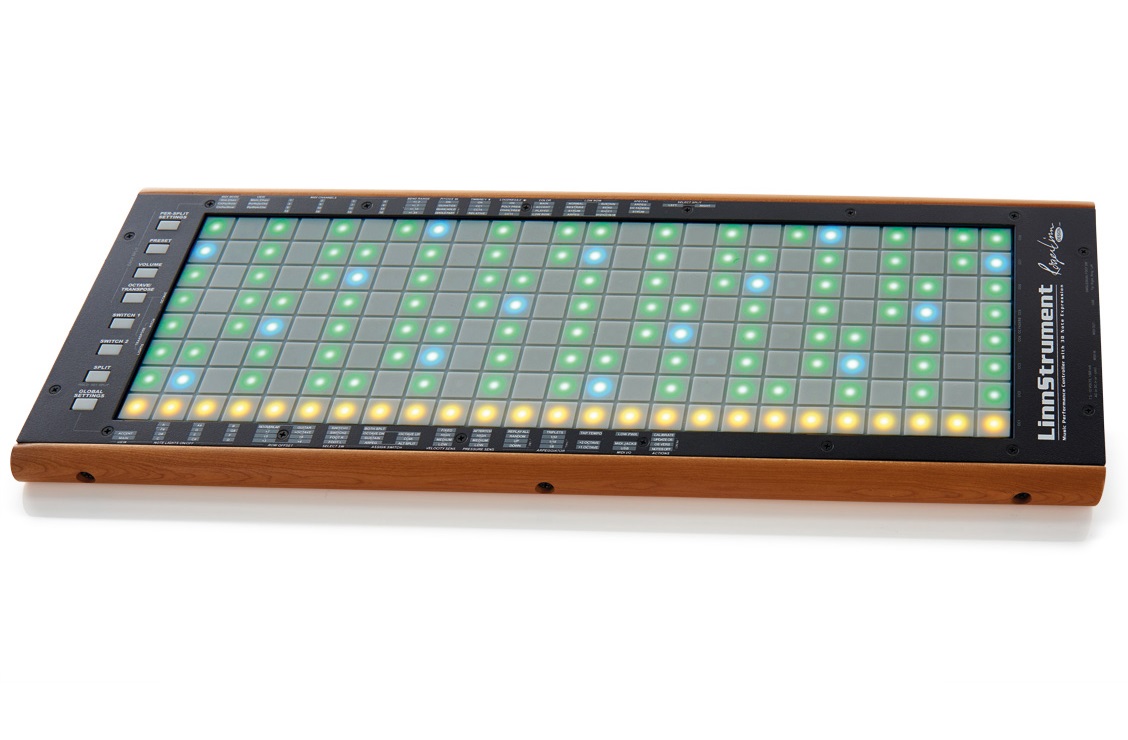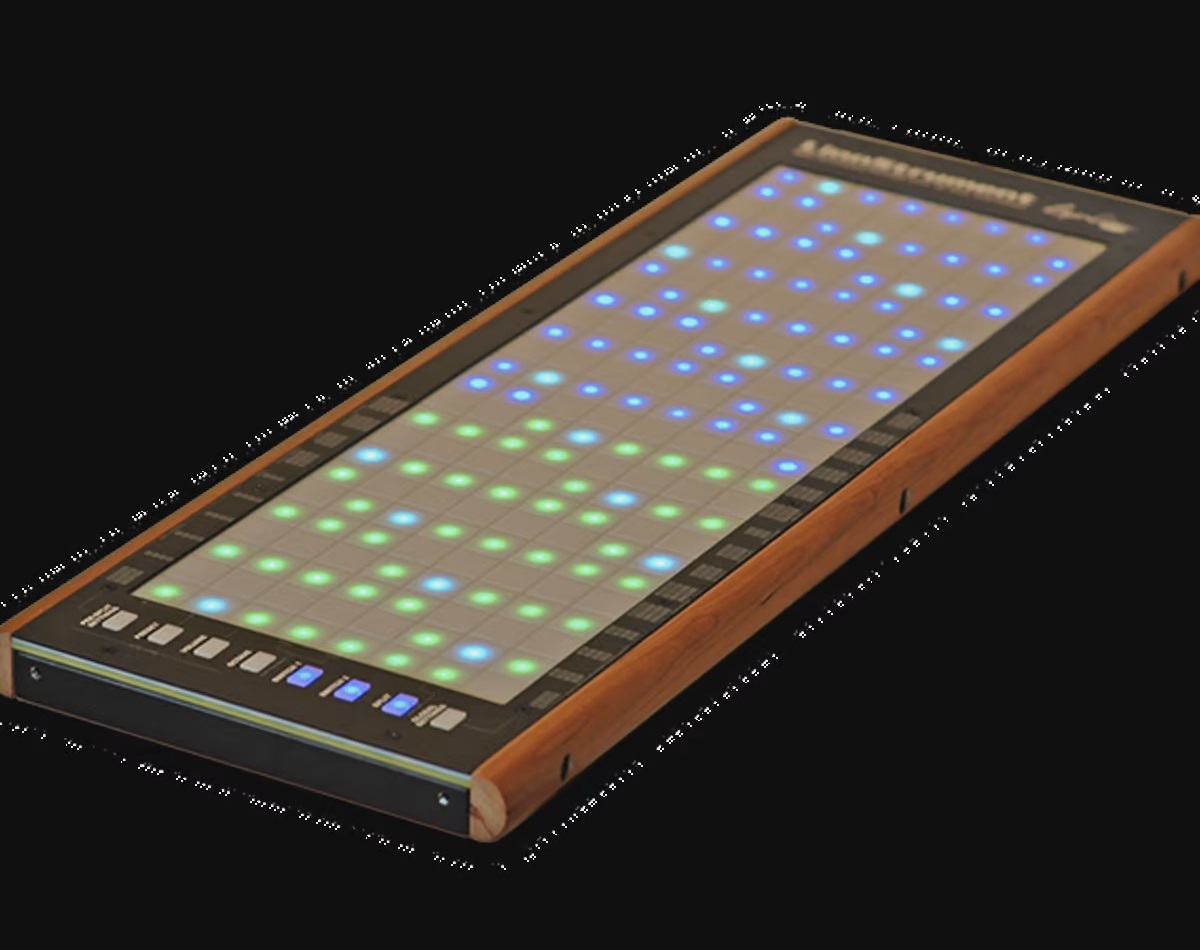LinnStrument
Electronic Instruments
America
Between 1901 and present
Video
The LinnStrument is a revolutionary electronic musical controller designed by Roger Linn, renowned for his contributions to music technology. Unlike traditional MIDI controllers, the LinnStrument offers a multidimensional playing surface that responds to various gestures, providing musicians with expressive capabilities akin to acoustic instruments. Its grid-based interface allows for intuitive control over pitch, timbre, and dynamics, making it a versatile tool for modern music production.
Description
At its core, the LinnStrument is a MIDI performance controller featuring a grid of touch-sensitive pads. Each pad responds to five dimensions of touch: strike velocity, pressure, left-right movement (pitch), front-back movement (timbre), and release velocity. This design enables performers to execute nuanced articulations, such as vibrato and pitch bends, directly on the surface. The instrument’s layout is customizable, accommodating various scales and note arrangements to suit different musical preferences.
Type of Instrument
The LinnStrument falls under the category of electronic musical instruments, specifically as a MIDI controller. It does not generate sound on its own but sends MIDI data to external synthesizers or software instruments. Its multidimensional polyphonic expression (MPE) capability sets it apart from standard controllers, allowing for per-note expressive control.
History
Origin and Development
Roger Linn introduced the LinnStrument in late 2014 after several years of development. Linn, already a pivotal figure in music technology with inventions like the LM-1 Drum Computer, sought to create a controller that bridged the gap between electronic and acoustic instrument expressiveness. The LinnStrument emerged as a solution, offering musicians a new way to interact with digital sound sources.
Historical Context
The LinnStrument’s development reflects a broader trend in the 21st century toward more expressive electronic instruments. As musicians increasingly sought tools that could convey the nuances of their performances, instruments like the LinnStrument provided the necessary technological advancements to meet these demands. Its design reflects a culmination of ideas from various continents, particularly North America, where it was created, and Europe, which has been influential in electronic music development.
Construction
The LinnStrument features a sleek, rectangular design with a grid of touch-sensitive pads covering most of its surface. The standard model offers an 8×25 grid, while the LinnStrument 128 provides a more compact 8×16 grid. The pads are illuminated with RGB LEDs, providing visual feedback and aiding in navigation during performances. The instrument is USB-powered and includes MIDI connectivity, ensuring compatibility with a wide range of devices.
Types
There are two primary versions of the LinnStrument:
- LinnStrument: The original model with an 8×25 grid, offering a broader range for performance.
- LinnStrument 128: A more compact version with an 8×16 grid, suitable for musicians seeking portability without sacrificing functionality.
Features
The LinnStrument, designed by Roger Linn, is an innovative MIDI controller that reimagines traditional keyboard and pad-based instruments by offering a highly expressive, touch-sensitive playing surface. Unlike conventional keyboards, the LinnStrument features a grid of soft, illuminated pads that respond to touch in three dimensions—X (left-right for pitch bends), Y (forward-backward for timbre control), and Z (pressure for dynamics and aftertouch). This allows musicians to achieve a level of expressiveness similar to stringed or wind instruments, making it ideal for electronic, experimental, and film music. Additionally, the LinnStrument supports MPE (MIDI Polyphonic Expression), enabling independent control of pitch, timbre, and volume for each note, offering an unparalleled depth of musical nuance. Its ergonomic layout, customizable settings, and versatility in controlling synthesizers and digital instruments make it a powerful tool for modern musicians seeking greater expressivity in their performances.
Sound Production
As a MIDI controller, the LinnStrument does not produce sound independently. Instead, it sends MIDI data to external sound generators, such as hardware synthesizers or software instruments. Its MPE capability allows for detailed expressive control over these sound sources, enabling dynamic and nuanced performances.
Playing Methods
Musicians interact with the LinnStrument by pressing and manipulating its touch-sensitive pads. The five dimensions of touch sensitivity allow for various expressive techniques:
Strike Velocity: Determines the initial volume or intensity of a note based on how quickly a pad is struck.
Pressure: Sustaining pressure on a pad can modulate parameters like volume or filter cutoff.
X-Axis Movement (Left-Right): Sliding fingers horizontally can control pitch bends or other assignable parameters.
Y-Axis Movement (Front-Back): Moving fingers vertically can modulate effects such as timbre or modulation depth.
Release Velocity: The speed at which a finger is lifted can influence the release phase of a sound.
These capabilities allow performers to execute techniques traditionally associated with acoustic instruments, such as vibrato, glissando, and dynamic articulation.
Roles in Music and Significance
The LinnStrument has carved a niche in contemporary music production and performance. Its expressive capabilities make it a valuable tool for composers and performers seeking to infuse their electronic music with the nuanced expressiveness of acoustic instruments. Additionally, its customizable interface allows musicians to explore new musical ideas and performance techniques, pushing the boundaries of modern music.
In summary, the LinnStrument represents a significant advancement in the realm of electronic musical instruments. By providing a highly expressive and customizable interface, it empowers musicians to explore new creative possibilities and bridge the gap between electronic and acoustic performance.
FAQ
What type of instrument is the LinnStrument?
The LinnStrument is a MIDI controller designed for expressive musical performance. Unlike traditional keyboards, it uses touch-sensitive pads that respond to various finger movements.
What are some key features of the LinnStrument?
Key features include polyphonic aftertouch, customizable layouts for note arrangement, MIDI compatibility for connecting to various devices, and RGB backlighting for visual feedback during play.
What materials are used in constructing the LinnStrument?
The LinnStrument features a sturdy metal chassis that houses its touch-sensitive pads. The pads themselves are designed with advanced touch-sensing technology for enhanced responsiveness.
 Links
Links
References
 Similar
Similar
Instruments
Other Instrument
Categories



















